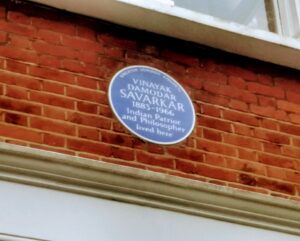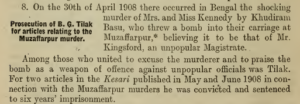
In my last essay, I have discussed of how explosive the activities in India House were. In continuation to that let me explain here how literally I mean by the term ‘explosive’. Yes, its India House from where Indian Struggle for Independence got its first ever bomb.
Congress aimed to gain freedom through ‘passive resistance’. By the way of non-cooperation, they envisioned to bend the Govt on their knees. By insistence on Swadeshi and rejecting the British product, they planned to bleed the Govt coffers. This was all to make the functioning of British Govt practically unviable and hence force them to negotiate. But this, according to Savarkar, was a utopian theory. He believed British Govt could very well wield the muscle power and resort to excesses to crush this ‘passive resistance’. Govt could break their own laws, promulgate new ones to suit their means and ends. As a solution he proposed to back this passive resistance with ‘Fire Power’. Arms and bombs was his plan and India House was on to it.
Indians Arms Act 1878 had made it illegal for any Indian to possess any weapon without a license and the procedure for that was very cumbersome. Savarkar planned to procure weapons from Russian, French, Turk, Irish and Egyptian revolutionaries, sneak them into India and distribute them into the promising hands. Back in India, his elder brother G D Savarkar and his mentor B G Tilak were party to this plan. Armed backing to the passive political resistance would force British to yield into the demands of India.
Savarkar, as the leader in the India House group, had assigned the task of obtaining the Bomb Manual to Pandurang Mahadev Bapat (Senapati Bapat) and Hemchandra Das (A Bengali revolutionary in London from Anusheelan Samitee). These two went to Paris to the old aides of India House Mr S K Verma and Mr. Sardar Singh Rana who in turn made them meet a Russian revolutionary, whose name is believed to be Nicholas Safranski. He had the Bomb Manual- but in Russian. Hemchandra Das, who was good at photography, took around 50 photos of the manual and developed them in France. Senapti Bapat knew a lady confidante in Germany who was also proficient in Russian and English. Both of them smuggled the photographs to Germany and got them translated. The Bomb Manual – one of the coveted accomplishments of India House was ready to teach Indian revolutionaries how to deafen their colonialists.
Bapat was so excited that he instantly wanted to blow up the British Parliament in London. It was Savarkar who pacified him by saying, ‘Blowing up the Parliament won’t win us freedom. We will be caught and hanged even before the Bomb Manual reaches India. We need to make sure that hundreds of these copies reach hundreds of the bomb makers in India before the British hear the first explosion in India. Now it was time for Bapat and Das to carry this transcript of the translated Bomb Manual into India. They sneaked it through the customs by hiding the manuals in the false bottoms of their luggage. In India these manuals reached various places like Bombay, Poona, Kolhapur, Nagpur, Indore, and Gwalior through Abhinav Bharat coordinated by Mr. G D Savarkar. Bapat and Das then took the Manual to Bengal to the leader of Anusheelan Samitee- Mr. Arobindo Ghosh.
Mr. Ghosh had a plan to bomb very unpopular Magistrate from Muzaffarpur Mr. Douglas Kingsford. A tender aged young man of 19, Khudiram Bose and his aide Prafulla Chaki were entrusted upon this job. In April 1908, they threw the bombs at a carriage that they supposed to be carrying Kingsford. But unfortunately it was carrying two Kennedy ladies, mother and her daughter, both of who died in the explosion. Kingsford escaped but the announcement for the arrival of the Bomb in Indian Freedom Struggle was made sound and clear. Indeed this was the first ever explosion from the hands of the revolutionaries in India. The making of the Bomb had originated in India House.
There was an instant crackdown wherein there were arrests and Anusheelan Samitee had all its prominent leaders caught. Chaki had committed suicide before being caught. Khudiram was tried upon and hanged. Barin Ghosh – The brother of Aurobindo Ghosh, Indubhushan Roy, Ulhaskar Dutt were tried upon and sentenced transportation to Andamans. The trial is famously known as Alipore Bomb Conspiracy case. Interestingly one of the originators of this Bomb – Mr. V D Savarkar, his aide and his brother Mr. G D Savarkar and the users of the Bomb – Anusheelan Samitee members: all met each other in Andamans.

(Excerpt from the Sedition Report 1918 By Sidney Rowlatt President of Rowlatt Commitee on Sedition mentioning about Tilak’s article)
Bomb was a big weapon in the hands of the revolutionaries in India. British had a big task at their hands. They understood the undertones of this blast and acted upon swiftly. As soon as there was an article commending the bombing in Muzaffarnagar in Tilak’s Kesari, British tried him for sedition and dispatched to Mandalays for 6 years. It was utmost necessary to jail the top Congress leaders to curb upon the ‘passive resistance’ knowing that the Indians are now heavily armed. One of the copy of the Bomb Manuals also was discovered from Tilak’s possession.
It’s noteworthy to mention here that the Scotland Yard in London and Department of Criminal Intelligence (DCI) in India had sniff of something big happening. There was massive correspondence between these two agencies between 1905 and 1908 before this explosion. There was a huge budget allocation and expenditures to the name of Scotland Yard on account of keeping an eye on the activities in India House. Despite of these facts India House was successful not only in detonating an explosion back in India but also making sure that the Manual reaches several hands in India.
After the arrival of the Bomb in India, there was a huge promise for the future. To celebrate this stupendous achievement Savarkar celebrated the Shivaji Jayanti in India House. They dedicated this success to the great Maratha warrior King Shivaji Maharaj. Who indeed was an inspiration to all the revolutionaries who were fighting for the Swaraj – Freedom of their Motherland.
Sources:
View Expressed are of the author’s and does not nexessarily reflect official position of Mimamsa – An Indic Inquiry
Author : Ameya Ranade
Ameya is Engineer by profession and writes frequently on Indian history, religion and philosophy.

Very informative, i believe haters will keep hating him no matter how many facts we present them. But it is the people who are neutral, need to be told the truth, specially the current generation.
Very nice informative article.
Yes. Indeed the truth need to be told. The aggressive false propaganda needs to be countered with facts